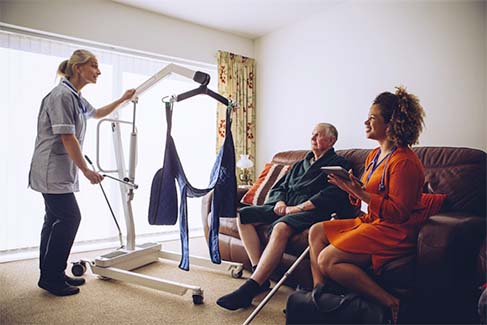When to use a Commode when Caring for Residents
A commode is a type of portable toilet and looks like a chair with a toilet seat. Rather than having running water, it has a pan (container) underneath the seat, which you can remove for cleaning after the commode is used.
When to use a commode
A commode is a valuable piece of equipment if a person is unsteady, weak, or at risk of falling. If a resident is unable to walk to the bathroom but can transfer, then using one can be a good option for their toileting needs.
A person must be able to sit safely on the commode. Depending on their mobility, you may need to help a person safely transfer to and from the seat.
If a resident needs extra assistance, you can also use a commode in combination with a toileting sling. Every resident should be assessed individually to ensure you know their level of independence, mobility, and assistance requirements.
- Make sure the commode is clean and the container is under the seat.
- Ask the resident you are helping where they would like it placed. Make sure you engage them at every point and explain what is happening so that they feel safe.
- Always check the wheels are locked, and the commode is secure before a patient uses it. If the commode is height adjustable, ensure it is set to the correct height. Check whether your patient might need a handrail nearby for support. Also, check if they need assistance with their clothes and fastenings.
- Try to give your patient privacy when using a commode if it is safe to do so. If you are able, turn away if you need to stay in the room. If you are leaving the room, ensure your patient can let you know when they are finished and remain close by in case they need you. Give them plenty of time so they don’t feel rushed.

Things to remember when helping a resident use a commode
Ensure you have everything you need before assisting someone with using a commode. You may need items such as:
- Disposable apron and gloves
- Toilet paper or wipes
- Warm water, cloth, and towel if required
Types of commode
Portable & folding commodes
These are lightweight with wheels designed to be easily moved around on all types of flooring. They can also be wheeled over a toilet for more privacy. You must ensure that the brakes are applied to lock the wheels when in use. This prevents the chair from moving so that you can safely help someone onto the commode.
Static
These do not have wheels and need to be carried from one location to another. They are stable and easily stackable. Some have detachable arms to make transferring from a chair/bed to the commode easier.
Bariatric
These are designed to accommodate bariatric patients; therefore are wider and take a larger weight limit.
Over the toilet frames
These are a basic frame and seat that are placed over the toilet. They are helpful to provide additional height and support when a resident can get to the toilet.
Shower commode chairs
These are similar to a portable commode but completely water-resistant. You can wheel this type of commode into the shower if required.

Best practice for proper cleaning
It is essential to clean a commode after every use to avoid the transmission of germs. If using one with a reusable pan, make sure the following procedures are followed:
- Wear protective clothing, including a disposable apron and gloves.
- Remove the commode pan carefully, avoiding spilling any contents.
- Empty the pan contents into the toilet.
- Wash the pan in a bucket of warm water and detergent with disposable cloths.
- Dry the pan with disposable paper towels.
- Wipe the pan down with 1000 ppm bleach and leave to air dry.
- Ensure you wipe down the frame with an appropriate disinfectant, then leave to air dry.
- Dispose of the cloths, paper towels, and other disposable items before removing your gloves and apron.
- Remove your gloves and apron, dispose of them appropriately, and wash your hands with soap and running water.
If you are unsure of the correct procedure, tools, and disinfectant to clean a commode properly, speak to your team leader for guidance.



